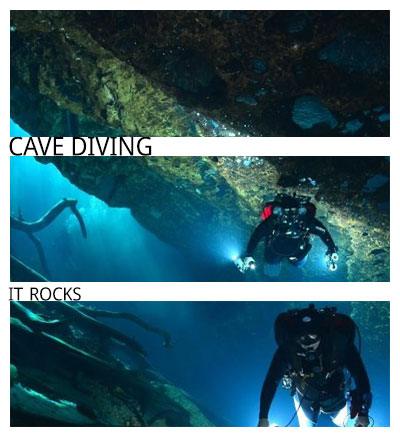National Speleological Society Cave Diving Section Courses
The following training course levels have been established for the NSS-CDS Training Program. The various training levels are designed and organized to encourage and allow for the participant to gain personal experience before they progress to another level. Certain training levels may be taught in combination at the discretion of the instructor as long as the proper sequence is maintained.
Cavern Diver
This course develops the minimum skills and knowledge for cavern diving and describes the dangers involved with cave diving. Planning, environment, procedures, techniques, problem solving and other specialized needs of cavern diving are covered. Problem solving in cavern diving includes, but is not limited to, body positioning (trim), buoyancy control, emergency procedures, line following and propulsion techniques. Accident analysis forms the basis of this learning experience. Special emphasis on the unique environment includes silting, entanglement, disorientation and equipment modifications. The Cavern Diver Course is in no way intended to provide instruction for cave diving.
This course level is an entry-level program for those interested in cave diving and is also a safety program for open water divers.
Basic/Intro to Cave Diver
This course covers the basic principles of actual cave diving. Accident analysis forms the basis of training. Basic/Intro Cave Diver follows the Cavern Diver courses as the Cave Diving Section’s second step in the development of safe techniques for cave diving. The basis of this course is aimed at continuing development of basic skills and the refinement of techniques and procedures required for the most elementary of cave dives. Cave dives are planned around very limited penetrations so that the diver may progress to cave diving at a conservative pace. The
Basic/Intro Cave Diver course is not intended to train divers for all facets of cave
diving. This course develops the minimum skills and knowledge required for limited penetration cave diving. Dive planning, cave environment, procedures, techniques,problem solving and other specialized needs of cave diving are covered.
Apprentice Cave Diver
This is the third in the series of cave diver development training courses. Emphasis is upon dive planning and skill refinement through actual cave dives. Techniques learned through the earlier Basic/Intro to Cave Diver and Cavern Diver courses are critiqued and expanded. Exposure to different cave diving scenarios is the foundation of this training.
The Apprentice Cave Diver course level represents the first half of the training
ultimately required to complete the Cave Diver level and is not intended to prepare divers for evaluating all facets of cave diving. It is intended to expose students to basic fundamental principles of cave diving. Students are encouraged to move on to the next level of training before attempting to plan and execute complex cave dives. A time-limited training card is issued upon completion.
Cave Diver
This is the fourth in the series of cave diver development training courses. Exposure to more sophisticated cave diving scenarios is the foundation of this training. Complex cave dive planning and execution is emphasized. Techniques learned during the previous training levels are refined in more challenging cave diving environments.
Stage Diving
This is a specialty course level. The purpose of the Stage Diving Specialty course is to expose the trained cave diver to the basic fundamentals of the safe use of stage cylinders for extended penetration diving in underwater caves while under the direct supervision of a qualified Stage Diving Specialty Instructor. The student is able to build practical experience in the field under controlled conditions. Safety and conservation practices, procedures and techniques common while stage diving the unique environment of a cave are covered to help develop the participant’ skills and knowledge in extended penetration diving with the use of a stage cylinder, longer decompression obligations and more complex navigation concerns are covered.
DPV Pilot
This is a specialty course level. The purpose of the DPV (Diver Propulsion Vehicle) Pilot specialty course is to expose the trained cave diver to the basic fundamentals of the safe operation of diver propulsion vehicles in underwater caves while under the direct supervision of a DPV Pilot Specialty Instructor. The student is able to build practical experience in the field under controlled conditions. Safety practices, procedures and techniques common to most DPVs used in the unique environment of a cave are covered. Conservation considerations such as low-impact operation are emphasized and potential emergency situations are simulated and practiced.
Sidemount Diving
is a specialty course level. The purpose of the Sidemount Diving specialty course is to expose the trained cave diver to the basic fundamentals of the use of alternative cylinder and harness configurations when back-mounted cylinders are not appropriate or available in underwater caves while under the direct supervision of a qualified Sidemount Diving Specialty Instructor.
Recovery Diver
is a specialty program. The Recovery Diver Program is a two-part program. The first part is an accident scene management-oriented program. The second part introduces procedures, techniques and equipment required for the extraction or rescue of a diver(s) lost in a cave. This program requires land drills and in-water training.
Deep Cave Diver
is a specialty course level. The purpose of the Deep Cave Diver specialty course is to provide the Cave Diver training for the safe planning and execution of mixed gas diving in caves to depths not exceeding three hundred (300) feet sea water/ninety (90) meters sea water while under the direct supervision of a Deep Cave Diver Specialty Instructor. The diver will be introduced to the proper and safe use of helium as a breathing gas, along with oxygen and nitrox for staged decompression. This course will emphasize precision and accuracy in all aspects of the dive beginning with advanced pre-dive planning. Safety will be a primary focus of this course due to the depths to which dives will be made.
Overhead Nitrox Diver
This is a specialty course level. The purpose of the Overhead Nitrox Diver specialty course is to provide divers with the basic knowledge and skills necessary to safely utilize enhanced air Nitrox (Nitrox) as a breathing medium while under the direct supervision of an Overhead Nitrox Diver Specialty Instructor. The course covers the use of Nitrox mixtures in the range of twenty two percent (22%) to forty percent (40%) oxygen content. The diver will be introduced to the proper and safe used of Nitrox as a breathing medium and will emphasize proper safety practices and procedures for the use of Nitrox.
Rebreather Cave Diver
This is a specialty course level. The purpose of the Rebreather CaveDiver specialty course is to provide divers with the basic knowledge and skills necessary to safely utilize rebreathers (either semi-closed or fully-closed) in overhead environments while under the direct supervision of a Rebreather Cave Diver Specialty Instructor. The diver will be exposed to the special hazards involved in the use of rebreathers in overhead environments as well as the techniques and procedures used to The program will also instruct candidates planning overhead environment dives with open circuit dive partners.


